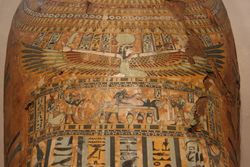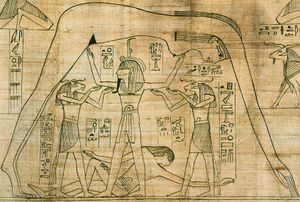نوت (إلهة)
| نوت أو نويت | |||||
|---|---|---|---|---|---|
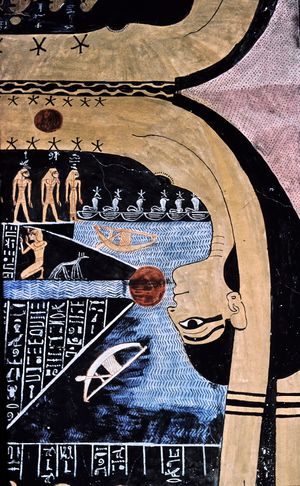 نوت والشمس . | |||||
| إلهة السماء | |||||
| الاسم بالهيروغليفية |
| ||||
| الرمز | إنسان ، أو بقرة ، أو شجرة | ||||
| الوالدان | تفنوت ، شو | ||||
| الأشقاء | جب | ||||
| Consort | جب | ||||
نوت أو نويت Nuit ،Nut ، Nuit ، Newet,Neuth : إلهة السماء وإحدى أقدم الآلهة المصرية التي يستريح العالم تحت جسدها. وهي زوجة الإله جب ، رزقت السماء والأرض بأربعة أولاد مكونين الجيل الرابع وهم على التوالي"أوزوريس"،"إيزيس"،"ست"و"نفتيس".
. . . . . . . . . . . . . . . . . . . . . . . . . . . . . . . . . . . . . . . . . . . . . . . . . . . . . . . . . . . . . . . . . . . . . . . . . . . . . . . . . . . . . . . . . . . . . . . . . . . . . . . . . . . . . . . . . . . . . . . . . . . . . . . . . . . . . . . . . . . . . . . . . . . . . . . . . . . . . . . . . . . . . . . .
التصوير
غالباً ما تم تصوير نوت بهيئة بشرية، وأحياناً بهيئة بقرة أو شجرة. من ألقاب نوت: “مغطّية السماوات”، “تلك التي تحمي”، “التي حملت كل الآلهة”، و”التي تحمل ألف روح”.[1]
ربة السماء
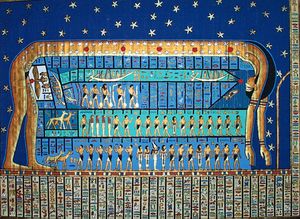
وهناك مفاهيم أخرى شعبية ترى في الشمس صورة طفل يخطو داخل فم إلهة السماء (نوت) في المساء ثم يمر خلال جسدها أثناء الليل ويولد منها من جديد في الصباح ، وأحيانا في صورة وليد صغير لإلهة السماء التي تتجسد في صورة البقرة السمائية . ولقد كان هناك أيضا مزج بين مختلف هذه التصورات عن الرحلة اليومية لإله الشمس ، وعلى ذلك فليس من المستغرب أن تنقش قصة (دمار البشر) ومعها رسم للإله (رع) في هيئته البشرية الكاملة مبحرا في قاربه المقدس على ظهر بقرة السماء (نوت) . وتمتد فكرة غروب الشمس باعتبارها ابتلاعا له بواسطة إلهة السماء إلى حركة نجوم السماء فهي ترى فها مجرد خنازير صغيرة تختفي في فم (نوت) حيث تلتهمهم في الصباح ، ثم تخرجهم مرة أخرى قبل بدء الليل . ولهذا السبب كانت كلمة (مسوت Mesut) في اللغة المصرية تعني حرفيا (وقت الولادة) . [2]
الأصول
كما في أسطورة هليوبولس ، نشأ الكون قد من ماء غير مشكل يسمى نون انبثق منه الإله آتوم الذي ظهر فوق ربوة تسمى الربوة الاولى أو ربوة الخلق -والإله آتوم يساوي الإله رع- ثم قام الإله آتوم بإيجاد التوءمين "شو " إله الهواء و"تفنوت " ربة الرطوبة وهما الذان أوجدوا بدورهما الإله "جب" إله الأرض والربة "نوت" ربة السماء .[3]
A huge cult developed about Osiris that lasted well into Roman times. Isis was her husband's queen in the underworld and the theological basis for the role of the queen on earth. It can be said that she was a version of the great goddess Hathor. Like Hathor she not only had death and rebirth associations, but was the protector of children and the goddess of childbirth.[4]
أسطورة نوت ورع
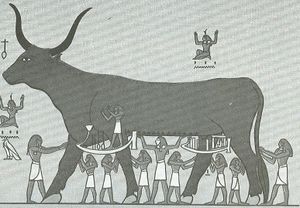
Ra, the sun god, was the second to rule the world, according to the reign of the gods. Ra was a strong ruler but he feared anyone taking his throne. When he discovered that Nut was to have children, he was furious. He decreed, "Nut shall not give birth any day of the year." At that time, the year was only 360 days. Nut spoke to Thoth, god of wisdom, and he had a plan. Thoth gambled with Khonsu, god of the moon, whose light rivalled that of Ra's. Every time Khonsu lost, he had to give Thoth some of his moonlight. Khonsu lost so many times that Thoth had enough moonlight to make 5 extra days. Since these days were not part of the year, Nut could have her children. She had five children: Osiris, later ruler of the gods and then god of the dead, Horus the Elder, god of war, Set, god of evil and wastelands, Isis, goddess of magic, and Nephthys, goddess of water. When Ra found out, he was furious. He separated Nut from her husband Geb for eternity. Her father, Shu, was to keep them apart. Nevertheless, Nut did not regret her decision.[بحاجة لمصدر]
بعض ألقاب نوت كانت:
- Coverer of the Sky: Nut was said to be covered in stars touching the different points of her body.
- She Who Protects: Among her jobs was to envelop and protect Ra, the sun god.[5]
- Mistress of All or "She who Bore the Gods": Originally, Nut was said to be lying on top of Geb (Earth) and continually having intercourse. During this time she birthed four children: Osiris, Isis, Set, and Nephthys.[6] A fifth child named Arueris is mentioned by Plutarch.[7] He was the Egyptian counterpart to the Greek god Apollo, who was made syncretic with Horus in the Hellenistic era as 'Horus the Elder'.[8] The Ptolemaic temple of Edfu is dedicated to Horus the Elder and there he is called the son of Nut and Geb, brother of Osiris, and the eldest son of Geb.[9]
- She Who Holds a Thousand Souls: Because of her role in the re-birthing of Ra every morning and in her son Osiris's resurrection, Nut became a key god in many of the myths about the afterlife.[5]
الدور
وقد تمتعت "نوت" بدور عقائدي جنازي حول فكرة إعادة البعث والميلاد لدى المصري القديم، إذ تشير النصوص إلى رغبة المتوفى في أن يصبح نجماً على جسد "نوت". ووفقاً لمذهب "عين شمس" في الخلق، فإن "نوت" قد اتحدت مع "جب" لإنجاب "أوزير"، والذي ارتبط بالبعث ودورة إعادة الحياة. وقد لعبت "نوت" دوراً هاماً في إعادة إحياء الملك المتوفى في "نصوص الأهرام"، حيث وردت الإشارة إليها في العديد من الفقرات؛ كما أنها لعبت الدور ذاته في "نصوص التوابيت".[10]
وكان الاعتقاد السائد بأن مصير المتوفى هو نفس مصير رب الشمس، حيث تخيل العقل المصري المفكر بأن المتوفى كان يمر في صحبة رب الشمس داخل جسد الربة نوت ربة السماء ليلاً، ليولد معه في شرق السماء في الصباح التالي، وهو ما عضدته نصوص الأهرام من الدولة القديمة.
She was often painted on the inside lid of the sarcophagus, protecting the deceased. The vaults of tombs were often painted dark blue with many stars as a representation of Nut. The Book of the Dead says, "Hail, thou Sycamore Tree of the Goddess Nut! Give me of the water and of the air which is in thee. I embrace that throne which is in Unu, and I keep guard over the Egg of Nekek-ur. It flourisheth, and I flourish; it liveth, and I live; it snuffeth the air, and I snuff the air, I the Osiris Ani, whose word is truth, in peace.''
كتاب نوت
كتاب نوت is a modern title of what was known in ancient times as أساسيات مسارات النجوم. This is an important collection of ancient Egyptian astronomical texts, perhaps the earliest of several other such texts, going back at least to 2,000 BC. Nut, being the sky goddess, plays the big role in the Book of Nut. The text also tells about various other sky and earth deities, such as the star deities and the decans deities. The cycles of the stars and the planets, and the time keeping are covered in the book.[11]
المصادر
- ^ الآلهة
- ^ ياروسلاف تشرني (1996). الديانة المصرية القديمة. دار الشروق للنشر.
{{cite book}}: Check date values in:|year=(help) - ^ الأساطير المصرية القديمة
- ^ خطأ استشهاد: وسم
<ref>غير صحيح؛ لا نص تم توفيره للمراجع المسماةDavid Leeming 2004 - ^ أ ب The Oxford Encyclopedia of Ancient Egypt, by Leonard H. Lesko, 2001.
- ^ Clark, R. T. Rundle. Myth and Symbol in Ancient Egypt. London: Thames and Hudson, 1959.
- ^ The Moralia - Isis & Osiris, 355 F, Uchicago.edu
- ^ Encyclopædia Britannica, Google Books
- ^ Emma Swan Hall, Harpocrates and Other Child Deities in Ancient Egyptian Sculpture, Journal of the American Research Center in Egypt Vol. 14, (1977), pp. 55–58, retrieved from JSTOR.org
- ^ مصريات
- ^ Alexandra von Lieven: Grundriss des Laufes der Sterne. Das sogenannte Nutbuch. The Carsten Niebuhr Institute of Ancient Eastern Studies, Kopenhagen 2007.
- Collier, Mark and Manley, Bill. How to Read Egyptian Hieroglyphs: Revised Edition. Berkeley: University of California Press, 1998.
- "Egyptian goddesses" The Oxford Companion to World mythology. David Leeming. Oxford University Press, 2004. Oxford Reference Online. Oxford University Press. Southeast Missouri State University. 7 May 2009.
- "Papyrus of Ani: Egyptian Book of the Dead", Sir Wallis Budge, NuVision Publications, page 57, 2007.
- The Oxford Encyclopedia of Ancient Egypt, by Leonard H. Lesko, 2001.
- Women of Ancient Egypt and the Sky Goddess Nut, by Susan Tower Hollis The Journal of American Folklore, 1987.
- pages.131-144,165,168(..sky-goddess...),174,194-196,243 of by Harco Willems(Leiden) copyrighted (1988) All Rights Reserved retrieved 21/09/2011
